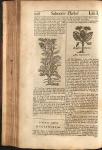 This chapter hasn't been proofread yet.
This chapter hasn't been proofread yet.
I. The Names. It is called in Greek, X ayejo,; In Latin, Brassica Sylvestris : and in English, Wild Colewort.
II. The Kinds. It is a singular Plant, and the second Species of Coleworts, being the Wild Kind.
III. The Description. It has a Root pretty thick, spread into some Branches, with several Fibres adjoining, white, hard, and somewhat woody, from whence rise up several Leaves, and one principal Stall The Leaves are long and broad, not much
unlike the common Garden Colewort leaf in shape, substance, and color, but that they are less, (as is also the whole Plant) being greyish, long, roundish Leaves, much gaffed or torn on the edges. Among these ground Leaves rises up the said Stalk, bearing such like, but smaller Leaves, which is spread forth into divers Branches : at the tops of which Branches, grow small yellow flowers, which being past away, they are succeeded by small rough Pods, which contain within them small round Seed. This Plant is of its own nature Wild, and therefore not used as food, or fought after for that purpose.
IV. The Places, It grows in most parts of England in open Fields, and new digged Ditch Banks, and such other like Grounds : and is in some places Husbanded and Sown for the Seed fake, which is many times very gainful.
V. The Times. It may be Sown in the Spring time, as in March and April, and sometimes in May. It Flowers in July, and the Seed is ripe in August or September.
VI. The Qualities, Specification, Preparations and Virtues, are the same with those of the Garden Colewort: ( except in the matter of eating them as Food, which is wholly forborn:) and for any Medicinal Use, whether internal or external : The Wild is much to be preferred, as being much stronger, and so more powerful to all the purposes and intentions, the Garden are said to be good for, or against.
Botanologia, or The English Herbal, was written by William Salmon, M.D., in 1710.

 Page 241
Page 241 Page 242
Page 242